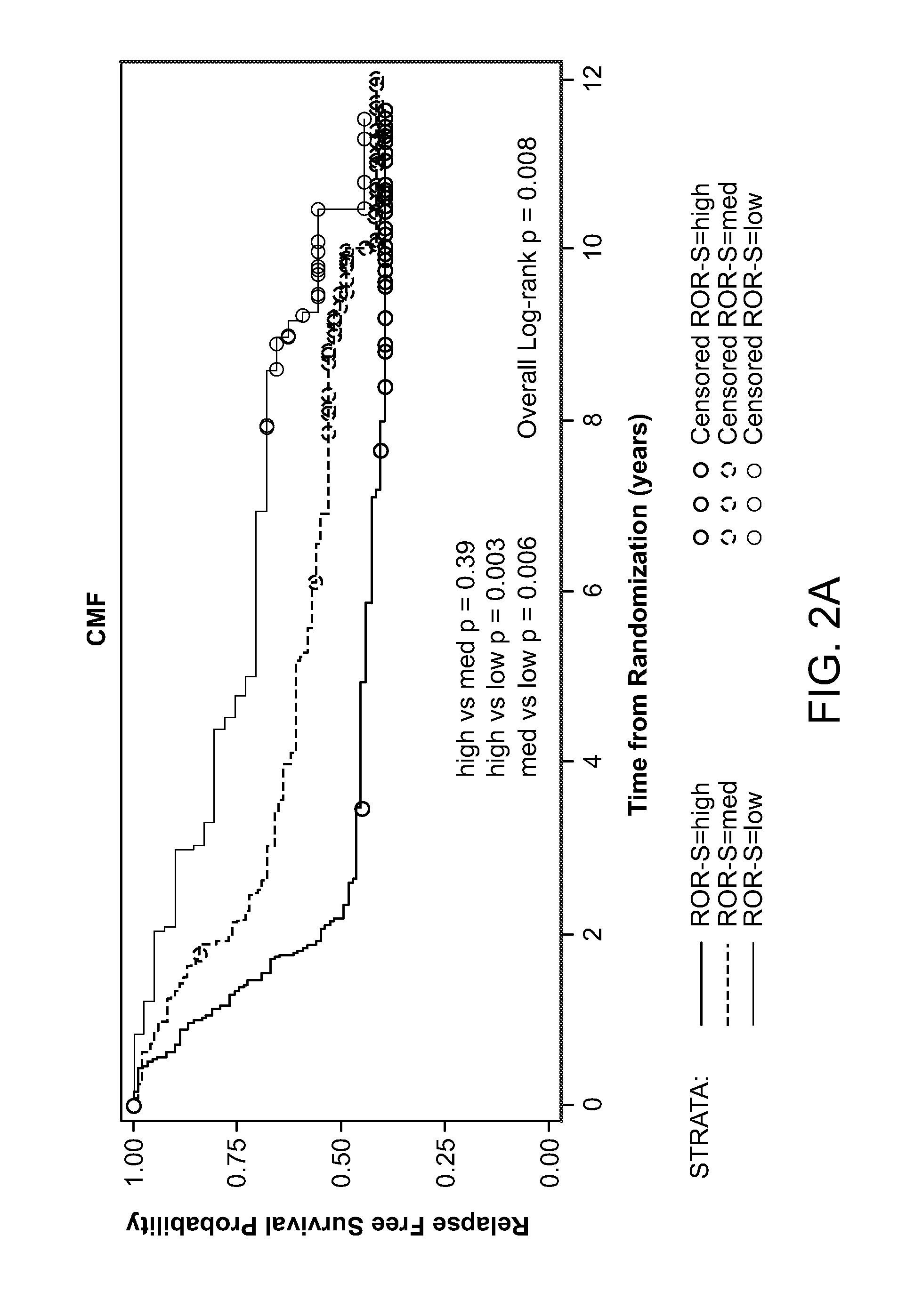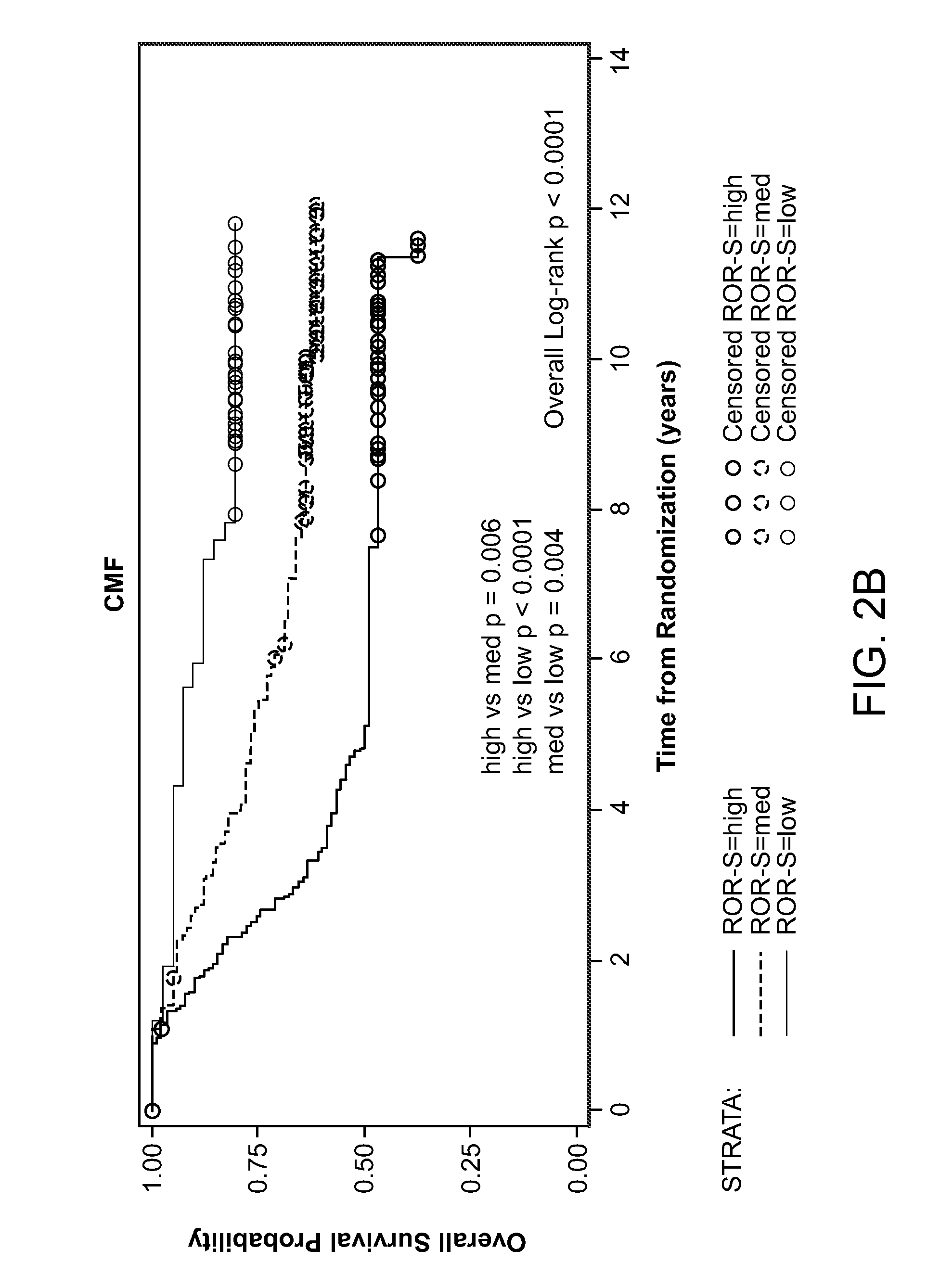Methods of Treating Breast Cancer with Anthracycline Therapy
an anthracycline and breast cancer technology, applied in the field of cancer biology, can solve the problems of severe side effects of anthracycline therapy, cardiotoxicity, secondary leukemia and vomiting,
- Summary
- Abstract
- Description
- Claims
- Application Information
AI Technical Summary
Benefits of technology
Problems solved by technology
Method used
Image
Examples
example 1
Classification of Tumors Using PAM50 and Immunohistochemistry (IHC) and Fluorescent In Situ Hybridization (FISH)
[0098]In this study, the PAM50 gene set was applied to 476 retrospectively collected tumor specimens from a NCIC-CTG MA.5 study, a prospective clinical trial that randomized women with pre-menopausal, node positive breast cancer to adjuvant chemotherapy with CMF vs. CEF.
Materials and Methods
[0099]Patients and Treatment Regimens
[0100]The MA.5 phase III trial was a randomized, controlled study on 716 premenopausal women with node-positive breast cancers (Levine et al., J Clin Oncol., 16(8):2651-8 (1998); Levine et al. J Clin Oncol., 23(22):5166-70 (2005)). In brief, patients were accrued between 1989 and 1993 and randomized to receive either CEF or CMF treatment regimens. The adjuvant CEF regimen included six cycles of epirubicin 60 mg / m2 and 5-fluorouracil (5-FU) 500 mg / m2, both delivered intravenously on days 1 and 8, and oral cyclophosphamide 75 mg / m2 daily on days 1 thro...
example 2
Association of Intrinsic Subtypes by qRT-PCR PAM50 with Survival and Subset Analysis
[0111]When analyzed on the entire cohort, intrinsic subtypes were significantly associated with different relapse-free and overall survival estimates (Table 4).
TABLE 4Survival by intrinsic subtypes by PAM50 in all patients.# ofRFS P-OS P-patients5-Year RFS (95% CI)values5-Year OS (95% CI)valuesSubtypeBasal-like9457.2% (47.1%-67.2%)Log-rank58.5% (48.5%-68.4%)Log-rankHer2-E10544.2% (34.7%-53.8%)0.000552.9% (43.3%-62.5%)LumA14670.5% (63.2%-77.9%)Wilcoxon91.8% (87.3%-96.2%)WilcoxonLumB11056.8% (47.5%-66.1%)75.8% (67.7%-83.9%)ROR-SHigh17450.6% (43.2%-58.1%)Log-rank53.4% (45.9%-60.9%)Log-rankMed20258.7% (51.9%-65.5%)0.008 79.6% (74.0%-85.2%)Low7974.7% (65.1%-84.3%)Wilcoxon93.7% (88.3%-99.0%)Wilcoxon0.0002
[0112]These results confirmed the prognostic values of subtypes among patients treated with adjuvant chemotherapy, regardless of the types of regimens. In this study, the ROR-S low-risk group (n=79) were a...
example 3
Selective Treatment Benefits Across Intrinsic Subtypes
[0115]In the MA.5 study subset with paraffin blocks available for this study, there was a trend for survival improvement for the anthracycline-containing regimen over the non-anthracycline, methotrexate containing control arm (FIGS. 3A and 3B) comparable in magnitude to that previously reported for the trial as a whole. HER2-E tumors demonstrated the greatest benefit from CEF versus CMF (FIGS. 3A and 3B), with an observed 21% gain in 5-yr RFS and 20% gain in 5-yr OS (FIGS. 4A and 4E). The interaction between HER2-E subtype and anthracycline sensitivity was significant for both endpoints (FIGS. 3A and 3B, p=0.03). In contrast, Basal-like tumors achieved no survival advantage for CEF over CMF, with a reverse trend having an observed 10% higher 5-yr OS for the CMF arm (FIG. 4f). The treatment effect differences between the two Luminal subtypes, which differ markedly in expression of proliferation genes, were also compared. Results f...
PUM
| Property | Measurement | Unit |
|---|---|---|
| fluorescence in situ hybridization | aaaaa | aaaaa |
Abstract
Description
Claims
Application Information
 Login to View More
Login to View More - R&D
- Intellectual Property
- Life Sciences
- Materials
- Tech Scout
- Unparalleled Data Quality
- Higher Quality Content
- 60% Fewer Hallucinations
Browse by: Latest US Patents, China's latest patents, Technical Efficacy Thesaurus, Application Domain, Technology Topic, Popular Technical Reports.
© 2025 PatSnap. All rights reserved.Legal|Privacy policy|Modern Slavery Act Transparency Statement|Sitemap|About US| Contact US: help@patsnap.com



